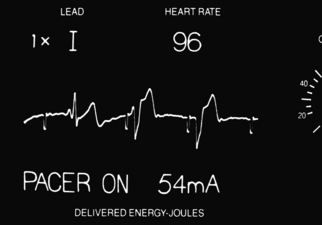PROCEDURE 52 • Knowledge of cardiac anatomy and physiology is needed. • Knowledge of cardiac monitoring (see Procedure 57) is necessary. • The ability to interpret basic dysrhythmias is needed. • Knowledge of temporary pacemaker function and expected patient responses to pacemaker therapy is needed. • Clinical and technical competence in the use of the external pacing equipment is necessary. • Indications for transcutaneous pacing are as follows1,6: • Temporary transvenous pacing is indicated when prolonged pacing is needed. • Contraindications for transcutaneous pacing are as follows2,6: • Pacing is contraindicated in severe hypothermia because cold ventricles are more prone to ventricular fibrillation and are more resistant to defibrillation.6 Transcutaneous pacing for an asystolic arrest is no longer recommended in the 2005 Advanced cardiac life support (ACLS) guidelines because of a lack of evidence that it improves survival rates.2 • External cardiac pacing is a temporary method of stimulating ventricular myocardial depolarization through the chest wall via two large pacing electrodes (patches). The electrodes are placed on the anterior and posterior chest wall and are attached by a cable to an external pulse generator (Fig. 52-1). The external pulse generator delivers energy (milliamps) to the myocardium based on the set pacing rate, output, and sensitivity. Some models of external pulse generators are combined with an external defibrillator, and the electrodes of these models may be used for pacing and defibrillation. • Sensitivity refers to the ability of the pacemaker to detect intrinsic myocardial activity. • In the nondemand or asynchronous mode, pacing occurs at the set rate regardless of the patient’s intrinsic rate. In the demand or synchronous mode, the pacemaker senses intrinsic myocardial activity and paces when the intrinsic cardiac rate is lower than the set rate on the external pulse generator. • Pacing occurs when the external pulse generator delivers enough energy through the pacing electrodes to the myocardium, which is known as pacemaker firing and is represented as a spike on the electrocardiographic (ECG) tracing (Fig. 52-2).
Temporary Transcutaneous (External) Pacing
PREREQUISITE NURSING KNOWLEDGE
 Symptomatic bradycardia unresponsive to medications
Symptomatic bradycardia unresponsive to medications
 In standby mode for the following rhythms in acute myocardial infarction setting4:
In standby mode for the following rhythms in acute myocardial infarction setting4:
![]()
Stay updated, free articles. Join our Telegram channel

Full access? Get Clinical Tree


52: Temporary Transcutaneous (External) Pacing








